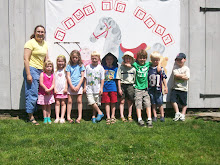Mom Knows Best
When I was a little girl my mom maintained two drawers for me - play clothes and school clothes. I remember on my first day of kindergarten being very proud that I got dressed all by myself, unfortunately I choose play clothes instead of school clothes and my mom had a very spiffy first day of school outfit ready to go. Long story short - I had to change. Longer story even shorter - nine years later I was voted "Best Dressed" at the end of my 8th grade year.
Bad Dressers
Many of us working at small not-for-profit organizations are bad dressers. We feel that because of the environments in which we work we can get away with fashion choices that would never be tolerated in the business world. Jeans and a cotton sweater are certainly comfy but if a big donor happens to pop in is that really the impression you want to make?
Dress for the Day
In all of my jobs to date I've been very blessed to have a wide variety of tasks that require a wide variety of clothing styles. When I teach summer camp I need to wear shorts and a T-shirt - ideally a t-shirt from my organization. If a big donor pops in on the middle of camp, I can be proud that I'm surrounded by happy, dirty kids and I know that my shorts and t-shirt choice was still a good one.
When I meet with a foundation, I put on a suit, (an in-style rather expensive suit with matching (polished) shoes and accessories) so that I look like a real Museum Director who will wisely and professionally steward their gift. Another good but also pretty obvious fashion choice for the task.
It gets tricker when you have a day when you think you will be sitting in your office by yourself. It's very tempting to choose the jeans and a sweater and sometimes I do and sometimes I get "caught" by people who should really be seeing me in more professional clothes. Not necessarily a suit but maybe slacks and a sweater.
Who Made These Rules?
When I was teaching my oldest son about matching clothes, he hated it and one day as he was heading back upstairs to change his mis-matched outfit he screamed "Who made these rules?'' It doesn't really matter who made them. What matters is that a lot of people still care about them.
Why does it matter - especially in a non-profit setting where we are supposed to be "above" silly things like earning a profit or the fashion rules of the business world? It matters because we usually get our funds, our audiences and our volunteers hours from people who work in the business world and will most likely hold us to the same standards. They will judge you and your staff and your volunteers by your appearance. How you present yourselves will be one of the factors they consider when they decide whether or not to donate, volunteer, join your board of directors or tell their neighbors a positive or a negative story about your organization.
Don't be the Docent in a Belly Shirt
A group of volunteers from my museum once visited another museum and received a tour from an overweight, older woman in a belly shirt. Guess what we talked about all the way home.
Don't be the docent in a belly shirt. Write a dress code for your organization. Honor it and hold your employees and your volunteers to it too.

